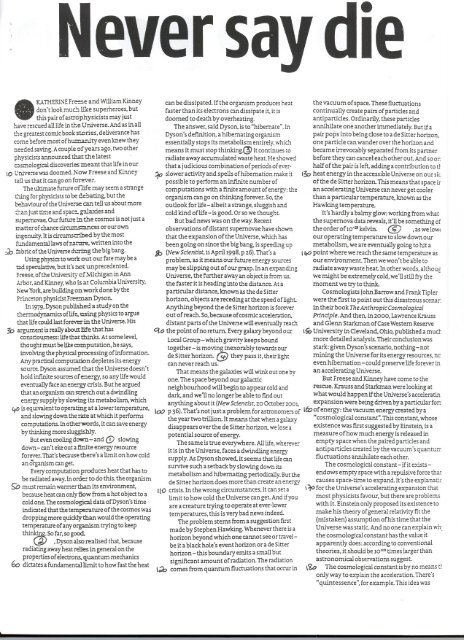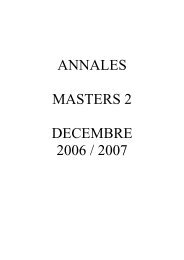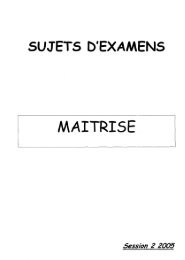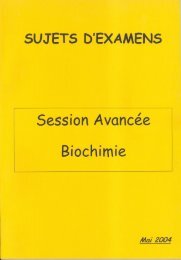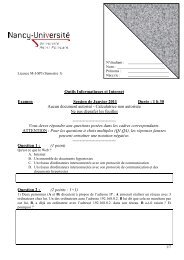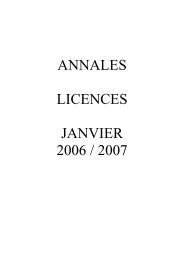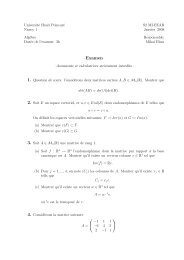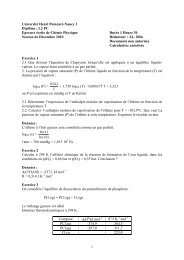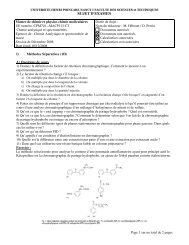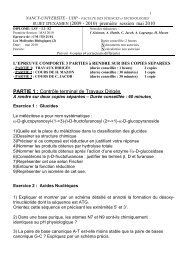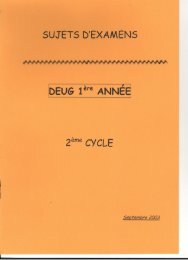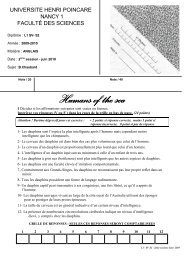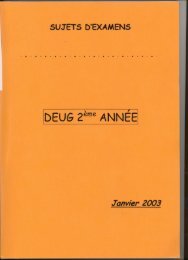You also want an ePaper? Increase the reach of your titles
YUMPU automatically turns print PDFs into web optimized ePapers that Google loves.
. eversa . le.KATHERlNEFr~e and WilliamKinneydon't look mu6like superheroes, butthis pair of astrcphysicists may justhave rescued alliife in the Universe. And as mailthe greatestcomic book s-..ories, deliverance bascorne before most ofhUD:laIÙty even knew theyneeded saving. Acouple ofyears aga, two otherphysicistsannounced thzt the latest .c:)smological discoveries meant that life in our10 t.:niverse was doomed. ~aw Freese and Kinneytell us that it can go on fcrever.The ultimate future oflife may seem a strangeL'ùng forphysicists to be debating. but thebehaviouroftheUniversec:an tell us about more:..':anjust tirne and spac~ gala.-des andsupernovae. Our future !Il the cosmos is net just amatter of chance cirt:uIDstances or our owni."1genuity.It is cirt:umsc-.;bed by the mostt ..:.ndamentallaws of natt1re, written into the;0 fubric of the Universe durlng the big bang.Using physics to worl::out our fate may be atad speculatÎVe,but it's net unprecedented.Freese, of the University cf Michigan in Ann:.rbor, and Kinney, who isat Columbia University,~ewYork. are building on ",'"Orkdone by thePrinceton physicist F~ Dyson.ln 1979,Dyson published a study on thet.~ennodynamics oflife. nsing physics to arguethatlife couldlastfor=-m the Universe.His?D argument isreally about1ife that hasconsciousness: life that thinks. At seme lever,thought must be likecomputation, he says,involving the physica1proœssing of information.Any practica1 computation depletes its energysource. Dyson assumed that the Universe doesn'tbord infinite sources of ene.'"gy,50 any life wouldeventually face an ene.'"gycrisis. But he arguedthat an organism can stre!ch out a dwindIingenergysupply by slowïng its metabolism, which'fO is equivalent to operatiDg at a lowertemperature,and slowing down the me atwhich it performscomputations. ln othe ,r;oords,it can save energyby thinking more sluggishly.But evencooling down-and (j) slowingdown -can't eke out afiDite energyresourceforever. That's becausetbere's a limitonhowcoldan èrganism can gelEvery computation produces heat that bas tobe radiated away.ln order to do this, the organism50 must remain warmerthan its environment,because heat can onlyfiow frOIDa hot abject to acold one. The cosmologk:al data ofDyson's timeindicated that the tempe.'4ture of the cosmos wasdropping more quicklythan would the operatingtemperature of any organism trying to keepthi~ 50 fil, sc good.~ ,DysonalsoreaIised that, becauseradiating away heat relies in general on theproperties of electrons. quantum mechanics60 dictates a fundamentallimit to how fast the heatcan be dissipated. Ifthe organism producesheat the vacuum of space.Thesefluctuationsfasterthan its electrons candissipate it,it is continually createpairs ofparticles anddoomed to death by overheating.antiparticles. Ordinarily,these particlesThe answer,said Dyson.is to "hibemate".In annihilate one another immediately. ButifaDyson's definition, a hibemating organism pair pops into being closeto a de Sitterhorizon,essentiany stops its metabolism entirely,whiÔ one particle canwander overthe horizon andmeans it must stop thinking~ it continuesto became iITevocablyseparated frOIDits partnerradiate away accumulated \Yasteheat. Heshowed Deferethey can canceleach orner out. Andsoor.that a judicious combination of periods ofever. half of the pair is left,adding acontribution to tf10 sloweractivity and spensofhibemationmakeitpossible to perform an Infinite numberofI~ heatenergyin the accessibleUniverseonourskof the de Sitter horizon.Thismeans that spaceircomputations with a finite amount ofenergy:the an accelerating Universecannever getcoolerorganism cangoon thinking forever.So,the than a particu1artemperature, known as theoutlook for life-albeit a smnge,sluggish and Hawking temperature.cold kind oflife-is good. Orsowe thought.l1'shardlya balmyglow: workingfrom whatBut bad newswas on the way.Recentthe supernova data reveals,it'n besomething ofobservations of distant supernovae have shawn the order of 10-29kelvin. @ ,as we lowtthat the expansion of the Universe,whichhas our operating temperature to slowdownourbeen going on since the bigbang. is speedingup metabolism, weare eventuallygoingto hit a9:> (NewSdentist, 11April 1998,p 26).That'sa IltOpoint where wereach the same temperature asproblem, as it means our future energysources ourenv1ronment. Then wewon't beabletomaybe slippingout ofourgrasp. ln an e."q)anding radiate awaywaste heat ln otherwords, althougUniverse, the further awayan abject isfrom us,the faster it isheading into the distance.Atawe rnight be extremely cold,we'ilstillfrythemoment we try to think.particu1ar distance,known as the de SitterCosmologists JohnBarrowand FrankTiplerhorizon, abjectsare receding at the speedoflight. were the fust to point out this disastrous scenar:Anything beyond the de Sitterhorizon isfore\'er in their book TheAnthropicCosmologicalout ofreach. So,because ofcosrnicacceleration. Prindple.AIld then, in2000, LawrenceKraussdistant parts ofthe Universewilleventuallyreach and Glenn Starkman of CaseWesternReserveGto the point of no retum. Everygalaxybeyondour I~ University in Cleveland,Ohio,published a muer.LocalGroup-which gravity keeps boundmoredetailed analysis.Theirconclusion wastogether -is moving inexorably towards our stark: given Dyson's scenario, nothing -netde Sitter horizon. (9 they pass it, their light mining the Universe ecrits energyresources, necan never reach us.even hibernation -couJd preservelifereleverinThat means the galaxies will winkout onebv an accelerating Universe.one.The space beyond our galactic . But Freeseand Kinneyhavecorneto theneighbourhood willbegin ta appear coldand rescue. Krauss and Starkmanwerelookingatdark, and we'llno longer be able to findout what wouJd happen if the Universe'sacceleratinanything about it (NewSdentist, 20October2001. expansion were being drivenbya particuIarfonI~ p 36).That's net just a problem for astronome."Sor 167of energy: the vacuum energycreated byathe year two trillion. It means that when agalaxy "cosmological constant".Thisconstant, whosedisappears overthe de Sitter horizon. welosea eXistencewas first suggestedbyEinstein,Isapotential source of energy.rneasure ofhow much energyis releasedinThe same istrue everywhere. Alllife,wherever empty space when the pairedparticlesandIt is in the Universe,faces a dwindling energy antipart!cles cre~t~dby the vacuum'squanturr.supply.AsDysonshowed. it seems that lifecan fluctuatIons annihilate eachorner.survive such a setback by slowing downitsThe cosmologicalconstant- ifit existsmetabolismand hibernating periodically.Butthe endows empty spacewith a repulsiveforcethatde Sitter horizon does more than create anenergy causes space-time to expand.lt's the explanaticIl0 crisis.ln the wrong circumstances, it canseta \~ for the Universe'sacceleratingexpansion thatHmitto how coldthe Universecan get.Andifyou most physicists faveur,but there are problemsare a creature trying to operate at ever-Iower with it. ~instein onlyproposed i~s.existencetotemperatures, this is verybad news indeed. m~ke hlStheory ofg~neralr~la:IVltyfittheThe problem stems from a suggestion fust (~staken) ass~ptlon ofhls rIme that th:made by Stephen Hawking.Wheneverthere isa Uruverse was ~tatlc.And no one canexpl~mwh:horizon beyond which onecannot seeor travelbeit ablack hole's event horizon ara deSitterthe cosmologIcalconsta?t hasthe valu.eItapparently does:accordmgto conventlonalhorizon -this boundary ernitsa small buttheories, it should be10"0rimeslargerthansignificant amount of radiation. Theradiation astronomical obs~rvationssu~est.l;b cornesfrOIDquantum fluctuations that occurin \


